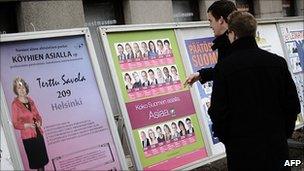True Finns' nationalism colours Finland election
- Published

Toni Paussu is one of the True Finns candidates in the capital Helsinki
An anti-immigration party in Finland - the True Finns - has surged in popularity and could produce a surprise in Sunday's general election, opinion polls suggest.
Jan Sundberg, Professor of Political Science at Helsinki University, looks at the True Finns phenomenon and the party's chances of joining the next coalition government.
The True Finns saw political potential among the neglected people in society. Their political message is two-fold: social-democratic welfare combined with nationalism and xenophobia.
They have targeted dissatisfied Finns who have suffered from the previous governments' economic policies.
The last time Finland faced a similar situation was in 1970, when the True Finns' predecessor, the Rural Party, surged from almost nothing to 18 seats in the 200-seat parliament.
Later the Rural Party split, but it made a successful comeback in the 1983 election.
'Embraced to death'
Finnish politics has been stable for years because ruling coalitions have integrated and then diluted the radical parties of left and right.

Wide choice: Outright victories are very rare in Finnish general elections
That was the fate of the Communists and, later, the Rural Party. Novelist Leif Salmen wrote that the Communists were "embraced to death". The True Finns emerged from the Rural Party in the 1990s when that party failed to keep its election promises.
Finland is officially bilingual, but the True Finns' nationalism has no room for Swedish. It excludes Swedish as something unfamiliar to Finnish culture. Polls suggest that most Finns share that view and want to stop the mandatory teaching of Swedish in Finnish schools.
There is also a widespread view that immigration is damaging Finland and Finnish culture.
Parties tend to follow popular trends among the electorate, even if they have an authoritarian streak. That is a general weakness of democracy.
The right-wing populist Danish People's Party is not a strong actor in Danish politics, but its xenophobia has spread to the major parties.
The Sweden Democrats, on the other hand, are kept isolated by all parties in the Swedish parliament.
In contrast to Sweden, parties in Finland have adopted - to differing degrees - the nationalist stance of the True Finns. That is certainly true of the Christian Democrats and Prime Minister Mari Kiviniemi's Centre Party.
Nationalist message
The True Finns' manifesto indicates they have much in common with right-wing populist parties elsewhere in Europe.
They believe that a low birth rate is not solved by immigration, as that results in problems and foreigners do not fit into Finnish culture. Instead, young women should study less and spend more time giving birth to pure Finnish children. That is like a faint echo of Nazi ideology.
If the True Finns do as well as expected the rival parties may opt for the traditional strategy of integration, but this time it is likely to backfire, because the economic climate has changed.
Finland suffered when the Soviet economy collapsed, because the USSR was a major export market for Finnish goods.
But in 1995 Finland joined the EU and Nokia developed into a globally successful mobile phone manufacturer. Finland joined the eurozone wholeheartedly in 2002.
But for many Finns today EU membership is no longer sexy - not when it involves bailing out countries like Greece, the Republic of Ireland and Portugal.
Other companies have caught up with Nokia and even the traditional "green gold" of Finland - timber - has lost its lustre. One paper and pulp mill after another has closed and many workers have been fired.
If the True Finns join the next coalition Finland will turn in some degree towards stronger nationalism and protectionism.
Correction 20 April 2011: This story has been amended to make it clear that it is the mandatory teaching of Swedish in Finnish schools that is in question - not a ban on teaching Swedish.
- Published20 September 2010